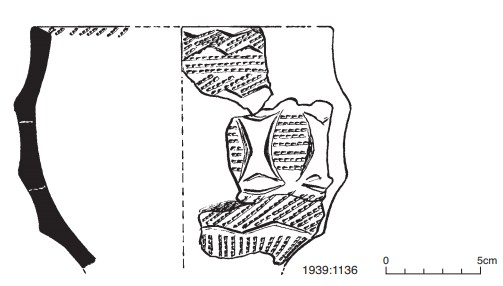County: Meath Site name: GAULSTOWN, CO. MEATH
Sites and Monuments Record No.: N/A Licence number: —
Author: JAMES TALLON
Site type: Early Bronze Age graves
Period/Dating: —
ITM: E 701292m, N 791081m
Latitude, Longitude (decimal degrees): 53.859293, -6.460194
Introduction
In July 1938 three human skeletons were discovered when an existing quarry pit was being extended near Balrath, Co. Meath. Two extended skeletons,241 accompanied by a boar’s tusk, were discovered first, and then a cremation242 accompanied by a bowl was found a short distance away.

The bowl had been broken by the workmen on discovery, but this and the other remains were collected by a local man, Mr James Tallon, who reported the find to the NMI. As the site was not visited by NMI personnel, this report is based on Mr Tallon’s account of the find.
Location (Fig. 3.135)
The site was described by Mr Tallon as being located in ‘Greene’s sandpit, near Balrath Post Office, Co. Meath’. The pit was said to be one mile from Balrath PO. The owners of the pit were identified as the ‘representatives of Henry Greene (deceased), Gaulstown, Balrath’. On the Ordnance Survey 6in sheet 32 a small sandpit can be seen a little less than a mile to the east of Balrath PO, close to Gaulstown House. It seems very clear that this was the site of the discovery in 1938.243
Description of site
No structure is recorded for any of the three burials discovered in the pit. The first two burials discovered are said to have been found in association with the foundation of a house, apparently consisting of ‘quarry stones and a lot of red bricks of rough make’. No further details are known as regards this structure.
Graves 1 and 2244
The burials consisted of two extended skeletons accompanied by a boar tusk (1939:1137). No details of disposition or orientation were noted.
Grave 3
This grave contained a cremation burial (1939:1138) accompanied by a bowl. Again, no details as to the position of either the vessel or the bones were recorded. Some unburnt animal bone was also found.
Ribbed bowl, 1939:1136 (Fig. 3.136)
The sherds constitute parts of a ribbed bowl (Ó Ríordáin and Waddell 1993, 122). The decoration on the sherds consists of false relief and rows of comb impressions. The rim is decorated with short comb impressions, and some of the sherds have a burnished appearance externally. A central band of decoration between the ribs is decorated with enlarged ‘thumbnail’ impressions forming a four-pointed star-like motif, between which are short rows of horizontal comb impressions. The vessel is fragmentary but was c. 10cm in height and up to 15cm in diameter at the mouth. The wall is 0.85cm thick.
Comment
The human remains from this site have not been dated. Owing to the nature of the investigation and the lack of detail, it is not possible to establish a clear association between the inhumations and the cremation. The presence of the boar’s tusk in grave 1 suggests a prehistoric burial, but it is not possible to be more precise in the absence of datable associated finds. The ribbed bowl from grave 3 is quite similar in terms of decoration to two bowls from Rush, Co. Dublin—a ribbed bowl (P1953:17; Ó Ríordáin and Waddell 1993, 221, no. 319) and a necked bipartite bowl (NMI 1934:432; ibid., 175, no. 88). This vessel is identified as belonging to stage 2 of the development of the bowl tradition, which is dated to 2080–1980 BC (Brindley 2007, 245–7). In 1946 further human remains were discovered in the gravel pit at Gaulstown.245 The gravel pit was being worked by Meath County Council, who collected the bones and had them reburied in another part of the pit. The discovery was reported to the Museum by Mr W. M.

Monks. As the remains were reburied before the Museum was informed, the site was never investigated, and no further information as to the type of burials is known.
HUMAN REMAINS
LAUREEN BUCKLEY
The total weight of cremated bone (1939:1138) from this site was 2g. There were eighteen fragments present, with the largest fragment measuring 17mm. Most fragments, however, were less than 10mm in length, and most were a blue/grey colour. They were probably human bone but were not identifiable. Also present were four large fragments of unburnt animal bone. The bone was very decayed and weathered.
241. Hereafter graves 1 and 2.
242. Hereafter grave 3.
243. Parish of Timoole, barony of Skreen. OS 6in. sheet 32. IGR 301363 264942.
244. These are dealt with together as so little information is available.
245. The precise location at which these bones were found was not recorded.